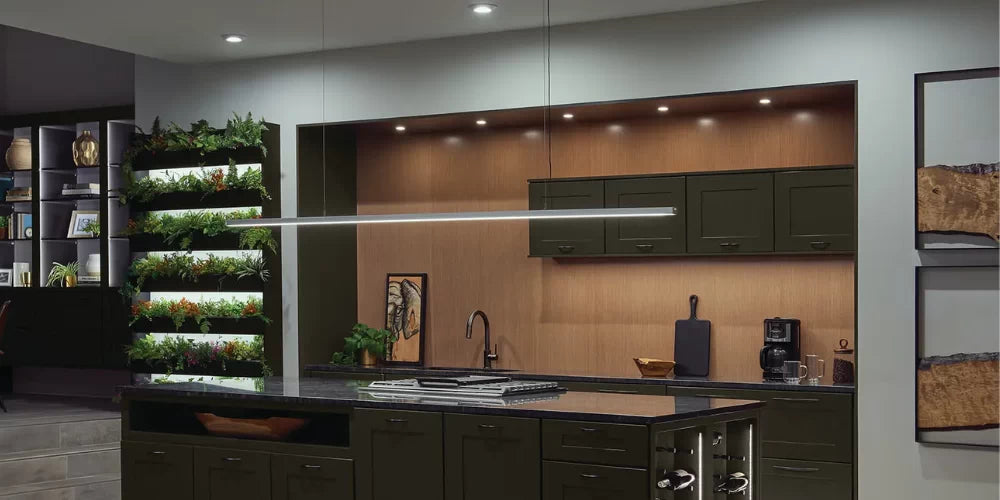Designing a kitchen lighting layout is a balance of science and style. Unlike a living room where light can be soft and ambient, the kitchen requires precision task lighting. If you place your fixtures incorrectly, you will end up working in your own shadow.
This guide covers the professional rules for spacing, placement, and sizing to ensure your kitchen is as functional as it is beautiful.
The Gold Standard: The "Half-Height" Spacing Rule
The most common question is: "How far apart should my lights be?" The professional answer is the Half-Height Rule. Divide your ceiling height by two to find your spacing interval.
- 8-foot ceilings: Space fixtures 4 feet apart.
- 10-foot ceilings: Space fixtures 5 feet apart.
Pro Tip: This rule ensures even light distribution across the "aisle" (the walking path) of your kitchen without creating dark spots.

Countertop Placement: Stop Working in Shadows
The biggest mistake in kitchen lighting is centering the lights in the middle of the walkway. When you stand at the counter to prep food, a light centered behind you will cast your shadow directly onto your workspace.
The Professional Placement Rule: Align your recessed lights with the edge of your countertops. Since standard countertops are 24 inches deep, your lights should be installed approximately 24 to 26 inches away from the wall. This ensures the beam of light falls directly onto the counter surface, providing shadow-free task lighting.
Wall Spacing and "Hot Spots"
To create a polished, professional look, you must manage how light hits your upper cabinets and walls.
- Avoid "Hot Spots": Keep fixtures at least 12 to 18 inches away from walls or the face of upper cabinets.
- Wall Washing: If you have open shelving or a textured backsplash you want to highlight, use adjustable gimbal fixtures positioned 18 inches out to "wash" the wall with light.

Kitchen Sizing Guide: 4-Inch vs. 6-Inch
While 6-inch lights were the traditional standard, modern kitchen design has shifted toward smaller apertures for a cleaner look.
| Size | Best Application | Why? |
| 4-inch | The Modern Standard | Provides a sleek, high-end look that aligns perfectly with modern cabinetry. |
| 6-inch | General Ambient | Best for high ceilings (10ft+) or large open kitchens that need broad coverage. |
| 2 or 3-inch | Accent & Niche | Perfect for lighting the inside of glass-front cabinets or bar niches. |
The Layered Look: Beyond Recessed Lighting
While recessed lights provide the "foundation" of your kitchen’s illumination, they work best when paired with other light sources. Following professional placement standards, we recommend a three-layer approach to eliminate shadows entirely.
- Layer 1: Ambient (Recessed Lights) These provide the general "fill" light for the room. Use the Half-Height Rule to space these evenly across your walking paths.
- Layer 2: Task (Under-Cabinet Lighting) Even perfectly placed recessed lights can be blocked by your upper cabinets. Adding under-cabinet LED tapes or pucks ensures your countertops are 100% shadow-free, creating a safer and more efficient workspace for food prep.
- Layer 3: Decorative & Task (Island Pendants) Islands are the focal point of the modern kitchen. While decorative pendants add style and eye-level light, they often don't provide enough intensity for heavy tasks.

The Professional Island Strategy: Do not rely on pendants alone. Supplement your island lighting by placing two 4-inch recessed lights over the work surface, positioned slightly in front of where you stand. This ensures that while you are prepping at the island, the light is coming from over your shoulder or directly above the surface, rather than from behind you.
The "Smart" Advantage: Tunable White Lighting
Modern kitchens are multi-purpose. You need bright, clinical light for cleaning, but warm, inviting light for entertaining. Smart LED lighting allows you to utilize Tunable White technology:
- 5000K (Daylight): Use this for food prep and cleaning to see every detail.
- 3000K (Soft White): Use this for dining and evening relaxation.
- Night Light Mode: Many smart fixtures now include a dedicated night light feature that provides a soft glow for safe navigation during late-night visits to the kitchen.
Lighting the Heart of Your Home
Achieving the perfect kitchen lighting doesn't happen by accident—it requires a strategic plan that balances task visibility with architectural style. By following the Half-Height Rule, prioritizing countertop placement, and layering your recessed lights with under-cabinet and island fixtures, you can transform your kitchen into a high-functioning workspace and an inviting social hub. Whether you choose the sleek profile of 4-inch downlights or the advanced versatility of smart LED technology, investing in a professional layout today will ensure your kitchen remains beautifully illuminated for years to come.





